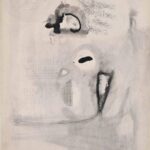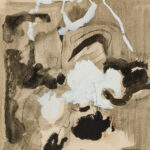Biography
Mark Rothko sought to make paintings that would bring people to tears. “I’m interested only in expressing basic human emotions—tragedy, ecstasy, doom, and so on,” he declared. “And the fact that a lot of people break down and cry when confronted with my pictures shows that I can communicate those basic human emotions….If you…are moved only by their color relationships, then you miss the point.”1 Like his fellow New York School painters Barnett Newman and Clyfford Still, Rothko painted to plumb the depths of himself and the human condition. For him, art was a profound form of communication, and art making was a moral act.
Born Markus Rothkowitz in Latvia in 1903, Rothko immigrated to the United States with his family in 1913. In 1921, he entered Yale University, leaving two years later. Like his peers, he found his direction and his place in New York. It was there, in 1925, that he began to study at Parsons School of Design under painter Arshile Gorky, who powerfully influenced him and many other Abstract Expressionists. Gorky and Rothko shared an interest in European Surrealism as evidenced by the biomorphic forms populating their paintings from the early 1940s. For Rothko, these forms would ultimately give way to the floating zones of color over colored grounds for which he would become known.
Rothko first developed this compositional strategy in 1947. Described as “Color Field painting” by critic Clement Greenberg in 1955—a term that stuck—it is a style characterized by significant open space and an expressive use of color. Rothko was one of its pioneers. “His colored rectangles seemed to dematerialize into pure light….” wrote MoMA’s former chief curator of painting and sculpture William S. Rubin. Rothko spent the rest of his career exploring the limitless possibilities of layering variously sized and colored rectangles onto fields of color.
By 1968, Rothko’s health was in decline from years of severe anxiety and his related drinking and smoking habits. After surviving an aneurism, he continued to smoke and drink despite his doctor’s orders, but he did scale back the size of his canvases and switch from oils to acrylic paints to reduce the strain that his painting process placed on his body. In 1970, at 66 years old, the chronically depressed artist committed suicide, leaving behind a body of work that brought him both critical and commercial success during his lifetime.

 Untitled
Untitled
 Untitled
Untitled